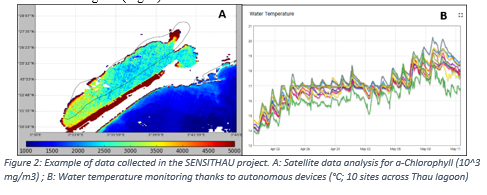SENSITHAU PROJECT: RISK ANTICIPATION – FOUR SOURCES OF DATA TO BUILT RISK PREDICTIVE MODELS
Introduction
Faced with the increase of harmful natural phenomena and infectious episodes, the shellfish and aquaculture industry in the world, has experienced major health crises since 2008 (Garcia et al. 2011). Several phenomena have disastrous consequences on the herds, such as microbial infections or anoxic crises (called “malaïgue”) (Hamon et al. 2003) resulting in a rapid depletion of oxygen in the environment, vital for organisms. Beyond shellfish farming, lagoon environments such as Thau Lagoon (France) are real reservoirs of biodiversity, directly impacted by these phenomena. The SENSITHAU project aims to integrate into the Lagoon Observation Network (ROL), an ecosystem database, for integrated management of the lagoon, combining ecology, health risks and shellfish production. Bringing together several key players in the Thau lagoon, the SENSITHAU project seeks the deployment of several in situ sensors measuring a wide range of physicochemical parameters in real time and at high frequency. Using data generated from in situ monitoring, sampling, and satellite, the project will be articulated around 2 axes:
- Deployment of an in situ telemetry network on various parameters of the lagoon water
- Development of predictive algorithms to anticipate risks associated with episodes of (i) malaïgue, (ii) microbial contamination and (iii) algal blooms.
Material and methods
The project takes place in the Thau Lagoon (Hérault, France), a semi-open environment.
Three datasets will be constructed to gather as many information as possible.
The 1st dataset is the physico-chemical data (temperature, dissolved oxygen, turbidity, salinity, and chlorophyll) monitored continuously (Aqurareal, Bioceanor) at 2 depth (surface and bottom).
The 2nd database is the water analysis from sampling at different strategic areas in the lagoon (where event occurs) of biotic (Escherichia. coli and enterococcus, phytoplankton) and abiotic (NO3, NH4, SO4, PO4, chlorophyll and phytoplankton diversity).
The 3rd database is the satellite images, exploring the analysis of 3 parameters (chlorophyll, backscattering coefficient of suspended inorganic matter and suspended particulate matter) using the Sentinel 2 and 3 satellite.
The 4th database includes other data such as wind, air temperature, rainfall level, flow rates of rivers and releases from wastewater treatment plants around the area.
The data is collected, harmonized, and stored for analysis. We will run preprocessing to identify the global behavior of different parameters (i.e., seasonality, extreme values). We will also analyze correlation between parameters to have a complete data exploration. At the end, we will build and compare various models: from statistical models to machine and deep learning methods to find the most performant one.
Results
The deployment of sensors and data collection in April 2021 constituted the first step for a global monitoring of the lagoon, including sensitives areas, susceptible for anoxic event, bacterial contamination, and blooms. All the sensors deployed in the lagoon represent a sentinel network for risk visualisation in real-time thanks to the continuous and connected devices. Different parameters monitored are redundant and measured at different scales (continuously with the autonomous devices, locally by sampling and by satellite). The data will be intercompared and will serve for statistical analysis. Those analysis will allow to identify key parameters and their variation overtime before, during and after an event of interest. Machine learning analyses will subsequently allow to anticipate events before they occur (Lafont et al. 2019). By the end of the project, correlation between in situ data and satellite images will give a role of sentinel for the satellite in the lagoon (Fig. 2). It will allow to alert the final user before an event occur.
Discussion and conclusion
The development of IoT (internet of things) simplifies the collection of large amounts of data, in real time and at high frequency. Correlated to water sampling and data collections that remains impossible autonomously, it will allow to build large and more robust data sets. Using these data with machine learning opens the world of anticipation (Lafont et al. 2019). Different risks exist for the industries dependent of the water quality (i.e. oyster farming). Being able to anticipate those risks can give advantage to protect the farm and the business against phenomenon that can be disastrous (HAB, oxygen drop, bacterial contamination…). The SENSITHAU project propose to develop tools to anticipate those risks. In long term, satellite data and continuous monitoring will allow to have a survey of the lagoon 24/7 and automatically alert end-user to a potential risk. The development of this technology will be applicable all around the world and will benefit to many sensitive areas, where anticipation of exceptional events is essential.
References
Garcia C, Thébault A, Dégremont L, Arzul I, Miossec L, Robert M, Chollet B, François C, Joly J, Ferrand S, Kerdudou N, Renault T (2011) Ostreid herpesvirus 1 detection and relationship with Crassostrea gigasspat mortality in France between 1998 and 2006. Vet Res 42:1–11
Hamon P-Y, Vercelli C, Pichot Y, Lagarde F, Le Gall P, Oheix J. Les malaïgues de l’étang de Thau. Tome 1. Description des malaïgues. Moyens de lutte, Recommandations.
Trotignon D, El-Farsi A, Schaeffer L, Lafont M, Dupont S, Dupont C (2020). Machine learning for aquaculture, improving water quality management and use predictive maintenance to ensure data reliability. Aquaculture Europe 2020 conference.
Lafont M, Dupont S, Cousin P, Vallauri A, Dupont C (2019) Back to the future: IoT to improve aquaculture: Real-time monitoring and algorithmic prediction of water parameters for aquaculture needs. Global IoT Summit (GIoTS), 1-6

